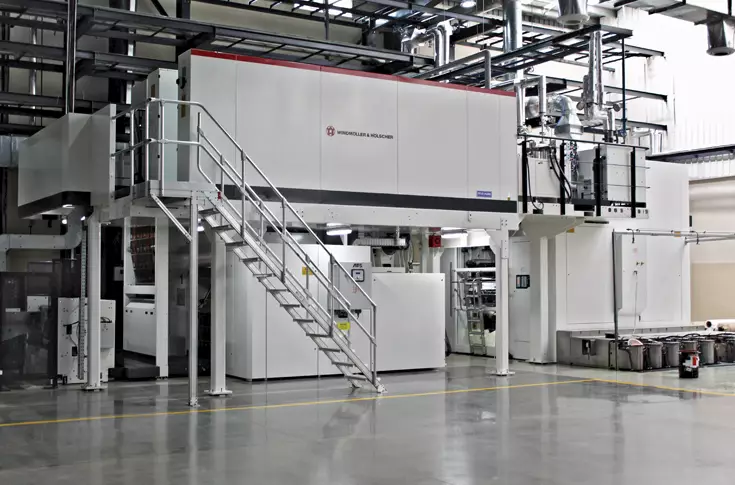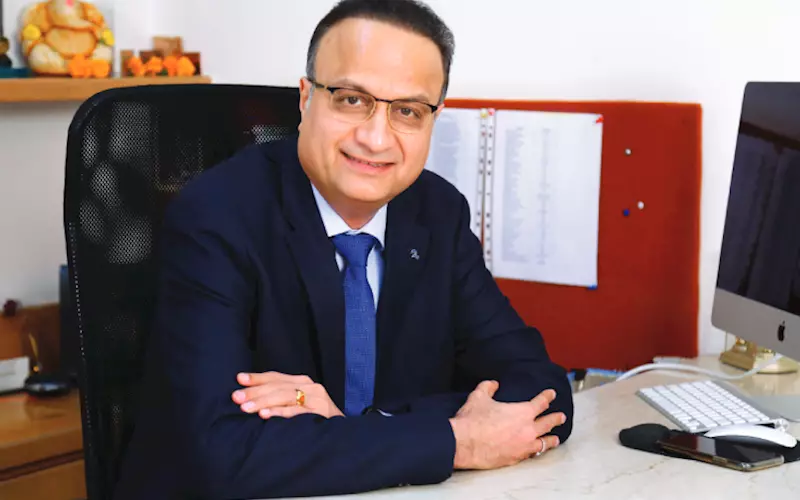"Every pack must extend the scope for recycling"
Reifenhäuser (India) Marketing (RIML) was founded in 1993 as a 50-50% joint venture with Reifenhäuser GmbH & Co. KG Maschinenfabrik, Germany. RIML has completed 25 years of operations in India. Manish Mehta, managing director, RIML talks to Ramu Ramanathan about the Indian packaging industry
19 Feb 2019 | By Ramu Ramanathan
You began your speech during the 25th-anniversary celebrations with a quote from Mark Twain. To quote Mr Twain: How were the past 12 months for you? Good, gooder, or could be better?
Could be better!
One question we keep getting asked by future investors is: What type of extrusions are the norm in India?
The main trend for the extrusion industry is – how to get more out of resin. To achieve this, the firm needs technically advanced machines, which keeps the customers ahead of the race. RIML is in the flexible packaging machinery, starting with blown film machinery, cast film, sheet lines, thermoforming and nonwoven machine for medical and hygiene use. Today the customer expects a lot more from a machine, which as a German machinery supplier, we are able to achieve.
Achieve what?
If we break these aspects, it will be – a reduction of expensive material by introducing cheaper resins and maintain same properties, reduction of expensive barrier resins, quick changeover which gives the producer an advantage of flexibility with less wastage where time is key. For instance, we offer Ultra Flat. This is a new standard set by RIML. Now, it is a proven norm in film lines. This helps to save 20-30% in adhesive usage.
Our advanced Mechatronics stack roller in sheet line is electromechanical, thereby avoiding the use of oil. This is fatal if it leaks on such food packaging. Also, RIML offers high-quality thermoforming and vacuum forming machinery whether it is PET sheet or barrier sheet. This is a growing market in India as well as exports.

The RIML Team – Bernd Reifenhauser, director; Ulrich Reifenhauser, chairman;Hamir Mehta, director and Manish Mehta, managing director (left to right)
Reifensauser has an association with 20 manufacturers. What's next in 2019?
The 3Ds: Focus on digital printing and digitalisation in the paper, converting plastic in alternate energy.
The latest report published by Research Report Insights the worldwide market is anticipated to record a CAGR of 6.7% throughout the projected period of 2017-2022. The market is expected to account for a market value of approximately USD 202-billion through the end of the projected year 2022. What is your estimation for India?
In view of the sustainability challenge and alternate options being worked by various research / R&D and multinationals, I would like to reserve my comment.
Which products do you see a boom?
In India, unit packaging and a technological film will always overshadow secondary packing.
Flexible packaging is characterised as any package or any piece of a package whose shape can be promptly changed. Is the Indian converter doing enough R&D in terms of form and structure?
R&D in terms of structure and packaging is, of course, limited as compared to advanced developed countries, especially, Japan and Europe. In that sense, we are trying to cope with it. The whole sustainability challenge is going to change the face of the packaging industry in the next 5-7 years.

There’s so much uncertainty/confusion in the Indian market about the plastics - as to what is recyclable, biodegradable and compostable.
Your view
I don’t want to add more confusion and uncertainty to what already exists. Recyclable, bio-degradable and compostable will co-exist. Of course one must consider economic viability and value for money. Lots of initiatives have been undertaken by private sectors and government organisations. We must support the process so that this uncertainty dies out soon.
Recycling and re-use and reduce?
In what way can we improve standards for the three Rs in India?
At Reifenhauser we follow “get more out of the resins” that’s why we have technology like Ultra Flat, Ultra Stretch, Mechatronics. And so, indirectly what we advocate is: 'reduce' should come before recycling and re-use.
Manish Mehta's market mantras

Which layers are most popular in India?
Monolayer was taken over by 3-layer. This was decades ago. Now the trend is five-layer for PE and has gained momentum. The barrier lines are for 7-layer and 9-layer. As of now, there is no 11-layer, but this will come soon.
The Indian market is dominated by ...?
Obviously PE. Due to growing applications in India. Boost in lifestyle changes and a need for longer shelf life packaging, barrier film/sheet market will ramp up significantly.
What is the preferred size of finished rolls?
For different applications, the finished roll size will vary. And so, for milk and oil film application which goes for printing, rolls are up to 1200 mm reel diameter. For collation shrink film rolls are 500 mm – 550 mm wide, hardly 150-200 mm diameter which goes into shrink heating tunnel.
Type of recycling in India?
Reifenhauser India represents NGR, Austria recycling lines. This ensures in-house recycling which is most popular among our customers. We have many installations of NGR lines for a variety of applications.
Post-consumer recycling and industrial waste recycling though exist, but they are mostly unorganised. Due to government regulations, we expect a huge demand for waste recycling through recovery and fulfilling EPR norms. The rollout of such schemes is on a pilot basis. We expect that there will be a foolproof system soon. All this is due to lack of systems which needs to be created from scratch. This is a time-consuming process.
What is RIML's experience with customers about savings on the machine? Any tangible instances of reduction in plastic and laminate consumption?
When we talk about reduction in the structure of a laminate, lots of exercises are underway. Many things are in transit. These are about minimising structures, paving way for PE/PE laminates by eliminating materials. Similarly, BOPP/CPP is expected to replace many PET-based structures. We have the technology Ultra Stretch in blown film or we call it MDO in CPP line, which will fit into such requirements. By addressing to technical needs of growing trends, Ultra Stretch also saves input energy thanks to its patented technology and unique positioning. This will be first of its kind in India but it has been proven in other markets worldwide.
Your favourite type of packaging?
Products with AlOx coating, barrier coatings will become prominent – and everything will need to extend the possibilities for good recycling.
The Indian growth is in which vertical?
PE-PE laminate in the detergent field and BOPP, CPP laminate in food packaging will become prominent in the time to come. Overall growth for flexible packaging business will be double than the GDP growth as I mentioned in my speech. I think this will be sustained. Narrow-web will march ahead. Since it has the branding and brand image window for most of the products. I see big growth in exports from India.
Can you suggest a few initiatives taken by you in the past 25 years to serve your customer better?
Initiatives by RIML have been in the field of bringing in innovative technology to the doorstep of the customer. We started with the solvent-less laminator, geared CI flexo, shaped pouches, retort pouches. Now the RIML team is working on water-based EB inks.

What is your wishlist for packaging?
My biggest wish is that more than 75% of food products, directly or indirectly, should be packaged to give safety and hygiene to the new generation of human kind. I would like to start with water, oil snack food, confectionary etc. with a reasonable shelf life. Plus packaging which prevents counterfeiting.
F&B is a key driver for market growth. One learning that you can share?
We were indirectly involved in juice packaging Paper Boat, for shaped pouches. Today, I see shaped pouches and retort pouches becoming a key driver for market growth.
The flexible packaging market is dominated by BOPP, BOPET, polyethylene, cast polypropylene, polypropylene, polyamide, ethylene vinyl alcohol, polyvinyl chloride and polystyrene.
What more should we be watching?
APET and PLA should be added to this list. And I have stated earlier, AlOx metalising is another area.
Any development in substrate science that we should we aware of?
Barrier coating on various kind of films, BOPP, BOPET. Also, I must say multilayer co-extruded barrier films will be key drivers too.
Manish Mehta - At a glance
How do you unwind?
Spend time with the grandchildren
One activity you love?
Cycling
Favourite films?
Life of Pi, Roman Holiday, Anand
Favourite holiday destination?
Himalayas
Favourite snack?
Vada Pav
Favourite book?
Autobiographies, since they depict reality
One beer you love?
Hoegaarden
One beer packaging you love?
Kingfisher Ultra, since it is easy to peel off
Your roots.
Morbi, Gujarat
Any roots in Morbi, still?
Most definitely, yes. I have very fond memories. I still visit Morbi. But it has become a modern city. The memories of childhood have disappeared as far as the city is concerned.
Many end-users seeking dispensing and reclosure alternatives. Any solution from Reifenhauser?
We can offer solutions from Totani Japan for pouching and spout inserting machines.
Packaging other than visual imagery and aesthetics is also about storing and transport. How does India compare to Western standards?
We need to create infrastructure and more supermarkets. We need to build outreach in the interiors of India, what we call as rural parts of India.
The growing use of rigid HDPE, and PC plastic canisters, bottles, and tanks as opposed to metal and/or glass for industrial packaging applications is expected to have a positive impact on industry growth. Is Reifenhuaser eyeing this space?
Reifenhauser, Germany is an extrusion machinery manufacturer. We will be talking about this in time to come with advanced blow moulding technology from Bekum Germany which is in the initial stage of our business activity.

Changing lifestyles and consumer preferences in terms of food are expected to propel the growth of the food and beverages industry in India, most notably for products that are ready-to-eat, thus influencing demand for plastic packaging in the region. What have you been witnessing in Gujarat, especially with MSME food brands which cater in farsan and namkeen.
Namkeen is extremely well packaged and covered under flexible packaging by various forms of the laminate. Farsan, as far as I know, many companies are still working with microwave oven options. I think they should be ready by end of the year.
You are known to be a tough cookie daring a deal. True or false.
(Laughs) That’s not fair.
Let me re-phrase that. One mantra you always follow during a negotiation.
One mantra is to find creative solutions - and have a win-win situation. For me, the customer is always the king.
What do you see as your personal challenges in your role, in the years ahead?
The body is old, the mind is young. The challenge is to cope with the speed and changes that are happening around us.












 See All
See All